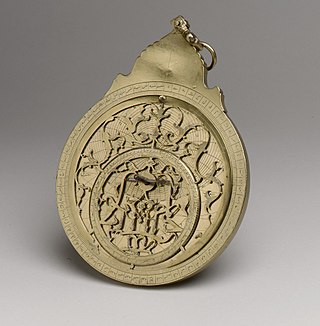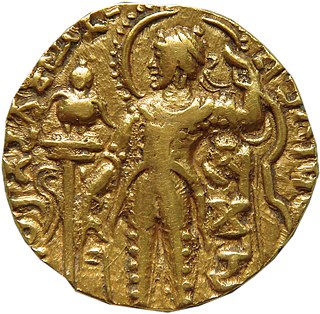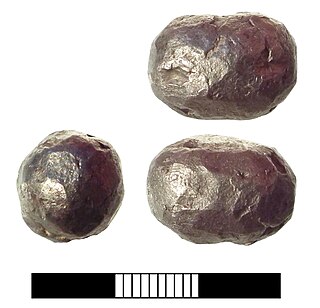Related Research Articles

An alloy is a mixture of chemical elements of which at least one is a metal. Unlike chemical compounds with metallic bases, an alloy will retain all the properties of a metal in the resulting material, such as electrical conductivity, ductility, opacity, and luster, but may have properties that differ from those of the pure metals, such as increased strength or hardness. In some cases, an alloy may reduce the overall cost of the material while preserving important properties. In other cases, the mixture imparts synergistic properties to the constituent metal elements such as corrosion resistance or mechanical strength.

Brass is an alloy of copper (Cu) and zinc (Zn), in proportions which can be varied to achieve different colours and mechanical, electrical, acoustic, and chemical properties, but copper typically has the larger proportion. In use since prehistoric times, it is a substitutional alloy: atoms of the two constituents may replace each other within the same crystal structure.

Bronze is an alloy consisting primarily of copper, commonly with about 12–12.5% tin and often with the addition of other metals and sometimes non-metals, such as phosphorus, or metalloids such as arsenic or silicon. These additions produce a range of alloys that may be harder than copper alone, or have other useful properties, such as strength, ductility, or machinability.

Metallurgy is a domain of materials science and engineering that studies the physical and chemical behavior of metallic elements, their inter-metallic compounds, and their mixtures, which are known as alloys.

Zinc is a chemical element; it has symbol Zn and atomic number 30. It is a slightly brittle metal at room temperature and has a shiny-greyish appearance when oxidation is removed. It is the first element in group 12 (IIB) of the periodic table. In some respects, it is chemically similar to magnesium: both elements exhibit only one normal oxidation state (+2), and the Zn2+ and Mg2+ ions are of similar size. Zinc is the 24th most abundant element in Earth's crust and has five stable isotopes. The most common zinc ore is sphalerite (zinc blende), a zinc sulfide mineral. The largest workable lodes are in Australia, Asia, and the United States. Zinc is refined by froth flotation of the ore, roasting, and final extraction using electricity (electrowinning).

Calamine is a historic name for an ore of zinc. The name calamine was derived from lapis calaminaris, a Latin corruption of Greek cadmia (καδμία), the old name for zinc ores in general. The name of the Belgian town of Kelmis, La Calamine in French, which was home to a zinc mine, comes from this. In the 18th and 19th centuries large ore mines could be found near the German village of Breinigerberg.

A crucible is a ceramic or metal container in which metals or other substances may be melted or subjected to very high temperatures. Although crucibles have historically tended to be made out of clay, they can be made from any material that withstands temperatures high enough to melt or otherwise alter its contents.

Cupronickel or copper–nickel (CuNi) is an alloy of copper with nickel, usually along with small quantities of other elements added for strength, such as iron and manganese. The copper content typically varies from 60 to 90 percent.

Group 12, by modern IUPAC numbering, is a group of chemical elements in the periodic table. It includes zinc (Zn), cadmium (Cd), mercury (Hg), and copernicium (Cn). Formerly this group was named IIB by CAS and old IUPAC system.

The cementation process is an obsolete technology for making steel by carburization of iron. Unlike modern steelmaking, it increased the amount of carbon in the iron. It was apparently developed before the 17th century. Derwentcote Steel Furnace, built in 1720, is the earliest surviving example of a cementation furnace. Another example in the UK is the cementation furnace in Doncaster Street, Sheffield.
Historically, the term "latten" referred loosely to the copper alloys such as brass or bronze that appeared in the Middle Ages and through to the late-18th and early-19th centuries. Such alloys were used for monumental brasses, in decorative effects on borders, rivets or other details of metalwork, in livery and pilgrim badges or funerary effigies. Latten commonly contained varying amounts of copper, tin, zinc and lead, giving it characteristics of both brass and bronze. Metalworkers commonly formed latten in thin sheets and used it to make church utensils. Brass of this period is made through the calamine brass process, from copper and zinc ore. This calamine brass was generally manufactured as hammered sheet or "battery brass", and cast brass was rare.

The history of metallurgy in the Indian subcontinent began prior to the 3rd millennium BCE. Metals and related concepts were mentioned in various early Vedic age texts. The Rigveda already uses the Sanskrit term ayas. The Indian cultural and commercial contacts with the Near East and the Greco-Roman world enabled an exchange of metallurgic sciences. The advent of the Mughals further improved the established tradition of metallurgy and metal working in India. During the period of British rule in India, the metalworking industry in India stagnated due to various colonial policies, though efforts by industrialists led to the industry's revival during the 19th century.
William Champion (1709–1789) is credited with patenting a process in Great Britain to distill zinc metal from calamine using charcoal in a smelter.

Ferrous metallurgy is the metallurgy of iron and its alloys. The earliest surviving prehistoric iron artifacts, from the 4th millennium BC in Egypt, were made from meteoritic iron-nickel. It is not known when or where the smelting of iron from ores began, but by the end of the 2nd millennium BC iron was being produced from iron ores in the region from Greece to India, The use of wrought iron was known by the 1st millennium BC, and its spread defined the Iron Age. During the medieval period, smiths in Europe found a way of producing wrought iron from cast iron, in this context known as pig iron, using finery forges. All these processes required charcoal as fuel.
In metallurgy, refining consists of purifying an impure metal. It is to be distinguished from other processes such as smelting and calcining in that those two involve a chemical change to the raw material, whereas in refining, the final material is usually identical chemically to the original one, only it is purer. The processes used are of many types, including pyrometallurgical and hydrometallurgical techniques.

Mining was one of the most prosperous activities in Roman Britain. Britain was rich in resources such as copper, gold, iron, lead, salt, silver, and tin, materials in high demand in the Roman Empire. Sufficient supply of metals was needed to fulfil the demand for coinage and luxury artefacts by the elite. The Romans started panning and puddling for gold. The abundance of mineral resources in the British Isles was probably one of the reasons for the Roman conquest of Britain. They were able to use advanced technology to find, develop and extract valuable minerals on a scale unequaled until the Middle Ages.
Zinc smelting is the process of converting zinc concentrates into pure zinc. Zinc smelting has historically been more difficult than the smelting of other metals, e.g. iron, because in contrast, zinc has a low boiling point. At temperatures typically used for smelting metals, zinc is a gas that will escape from a furnace with the flue gas and be lost, unless specific measures are taken to prevent it.

Metals and metal working had been known to the people of modern Italy since the Bronze Age. By 53 BC, Rome had expanded to control an immense expanse of the Mediterranean. This included Italy and its islands, Spain, Macedonia, Africa, Asia Minor, Syria and Greece; by the end of the Emperor Trajan's reign, the Roman Empire had grown further to encompass parts of Britain, Egypt, all of modern Germany west of the Rhine, Dacia, Noricum, Judea, Armenia, Illyria, and Thrace. As the empire grew, so did its need for metals.
Experimental archaeometallurgy is a subset of experimental archaeology that specifically involves past metallurgical processes most commonly involving the replication of copper and iron objects as well as testing the methodology behind the production of ancient metals and metal objects. Metals and elements used primarily as alloying materials, such as tin, lead, and arsenic, are also a part of experimental research.
C41100 Lubaloy is a wrought copper alloy that is composed mainly of copper and zinc. Lubaloy possesses many favorable characteristics making it, and other types of brass, a popular choice in manufacturing. It is a source material in many processes including the creation of electrical components and bullet-making. There are both positive and negative health effects that are associated with the use of this material.
References
- Notes
- ↑ Near this place in the year 1568 Brass was first made by alloying Copper with Zinc. To commemorate the event and on the occasion of the Diamond Jubilee of the National Brassfoundry Association, this plaque was erected in 1957
- ↑ The plaque also claims though that the brass was made with copper and zinc, which is so unlikely at this date as to make the claimed date also slightly suspect.
- Citations
- ↑ Day, J. (1973). Bristol Brass. David & Charles. ISBN 0-7153-6065-5.
- ↑ "A Short History of Baptist Mills Brass Works - Part One: The Early Years, 1700 - 1720". Archived from the original on 2005-03-10. Retrieved 2005-08-03.
- Bibliography
- Alexander, W.O. (1955). "A Brief Review of the Development of the Copper, Zinc and Brass Industries in Great Britain from AD 1500 to 1900". Murex Review. 1 (15). Archived from the original on 2007-04-17. Retrieved 2007-04-24.
- Tylecote, R. F. (1991). A History of Metallurgy (2nd ed.). Institute of Materials. p. 84. ISBN 978-1-9026-5379-2.
- Donald, M. B. (1961). Elizabethan Monopolies . Oliver and Boyd. pp. 179–95.
- Day, J.; Tylecote, R. F., eds. (1991). "Copper, Zinc and Brass Production". The Industrial Revolution in Metals. Institute of Metals. p. 200. ISBN 978-0-9014-6282-4.